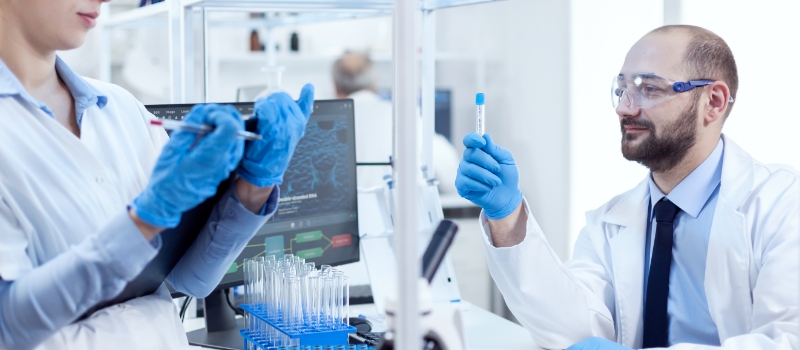Understanding How Analytical Testing Works: 5 Common Methods Used For Materials Analysis
Analytical testing, also known as materials testing, is the process of examining and evaluating the physical and chemical properties of samples. Several industries, including environmental, pharmaceutical, and food and beverage, often use materials analysis to ensure the efficacy and safety of substances and products.
An analytical laboratory analyst determines the quality and purity of samples using different material testing equipment and appropriate analytical testing methods. Scientists and researchers then use the critical information gathered through testing to develop or improve products.

Common Analytical Chemistry Techniques
Various analytical testing methods are available, but choosing which one to use entirely depends on the type of sample and the data needed. Here are five common methods and specific techniques used by lab technicians for material analysis:
Immunoassays

Immunoassays are done in different fields, including medical diagnostics and food safety. They detect proteins, hormones, and other target molecules using the properties of antibodies and are essential in monitoring and identifying diseases. Here are some popular types of immunoassays:
- Radioimmunoassays (RIA) - determine important compounds in biological fluids using radioisotopes.
- Fluoroimmunoassay (FIA) - similar to RIA, except it uses fluorophore as the label instead of radioisotope.
- Enzyme Immunoassays (EIA) - function similarly to RIA but replaces the radioisotope label with an enzyme.
Chromatography Testing

Chromatography analyzes and separates complex mixtures into their components based on physical and chemical properties. Lab analysts use chromatography reservoirs and flow controls with other supplies typically found in a chromatography lab to break down substances in the mobile phase into their components in the stationary phase.
HPLC testing is one of the most popular analytical testing methods. Besides HPLC analysis, other types of chromatography are available, such as ion exchange chromatography, gel filtration chromatography, and reverse phase chromatography. Here are some of the most widely used approaches to chromatography testing:
- Gas Chromatography (GC) - analyzes volatile and semi-volatile organic compound mixtures.
- Gas Chromatography-Mass Spectrometry (GC/MS) - detects and tests trace-level impurities in complex mixtures.
- High-Performance Liquid Chromatography (HPLC) - tests polymer antioxidants, UV absorbers, and other non-polar compounds.
- Column Chromatography (CC) - purifies compounds by separating solid and liquid samples using chromatography columns based on their hydrophobicity or polarity.
Spectroscopic Analysis

Spectroscopy involves the interaction of matter with electromagnetic radiation, including X-ray, ultraviolet, visible, or infrared light. It determines the sample's molecular structure, concentration, and other properties by measuring how much radiation the sample absorbs, emits, or scatters.
Fluorescence spectroscopy, atomic absorption spectroscopy, and other types of spectroscopy tests specialize in specific functions. Here are other spectroscopy techniques commonly used in chemistry, biology, and other fields besides photoelectron spectroscopy and NIR spectroscopy:
- Ultraviolet-Visible Spectroscopy (UV-Vis) - determines how much UV and visible light are absorbed and transmitted by the sample by analyzing its concentration and purity.
- Fourier Transform Infrared Spectroscopy (FTIR) - detects functional groups in a sample through spectral matching and identifies covalent bonding information.
- X-Ray Spectroscopy (XPS) - distinguishes the amount and type of crystallinity and analyzes atomic structure arrangements.
Microscopy Testing

Widely used in nanotechnology, environmental monitoring, and materials science, microscopy provides a better understanding of the sample’s structural features on micro and nano scales. The three main types of modern microscopy are scanning probe, optical, and electron microscopy. These are the microscopy techniques typically offered in a material testing lab:
- Optical Microscopy (OM) - magnifies a sample area by 10x to 1,000x using visible light.
- Transmission Electron Microscopy (TEM) - uses an electron beam to obtain a better resolution of samples down to molecular levels.
- Atomic Force Microscopy (AFM) - provides a high nano-level resolution view of a flat specimen surface using a mechanical cantilever with a sharp tip.
Electrochemical Analysis

Electrochemical analysis determines the chemical reactivity of a solution or complex samples, such as industrial effluents and environmental samples. It causes analytes of interest to undergo oxidation or reduction reactions. Electrochemical methods are ideal for mineral analysis, battery research, and corrosion engineering. Here are some of the standard techniques used in electrochemistry:
- Cyclic Voltammetry (CV) - studies electron transfer-initiated chemical reactions and the oxidation and reduction processes of molecular species.
- Amperometry - determines the concentration of electroactive species present in a solution.
- Potentiometry - distinguishes the concentration of a solute in solution.
Where Can You Perform Analytical Testing Methods?
Material testing techniques and methods are performed in a laboratory by a trained and skilled professional, such as a lab analyst, a forensic scientist, or an academic researcher. Laboratories are complete with various material testing equipment and supplies, including mass spectrometers and ultra-pure acetonitrile for LC/MS applications. Some analytical testing methods, however, can be done in the field when obtaining immediate results is necessary.
Sources:
https://www.intertek.com/analytical-laboratories/technologies/
https://www.tasconusa.com/material-analysis.html
https://pubs.acs.org/doi/10.1021/a1999901%2B
https://www.polymersolutions.com/capabilities/chromatography-lab/
https://www.polymersolutions.com/capabilities/spectroscopy-lab-services/
https://www.intertek.com/analysis/ftir/
https://www.polymersolutions.com/capabilities/microscopy-testing-lab/
https://www.eag.com/techniques/electrochemical-analysis/
https://www.sciencedirect.com/topics/engineering/electrochemical-method
https://infinitalab.com/metrology-testing-service/electrochemical-analysis/
https://pubs.acs.org/doi/10.1021/acs.jchemed.7b00361
https://pubs.acs.org/doi/10.1021/ed043p378
https://www.sciencedirect.com/topics/nursing-and-health-professions/potentiometry
http://www.cpeo.org/techtree/ttdescript/imuass.htm
https://www.ncbi.nlm.nih.gov/pmc/articles/PMC3614608/
https://www.sciencedirect.com/topics/agricultural-and-biological-sciences/column-chromatography

